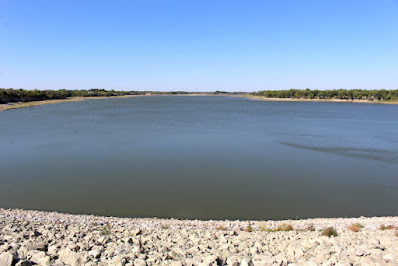When I drove into McCook (population 7,446), Nebraska, I immediately recognized a house designed by Frank Lloyd Wright. The six-bedroom, 4,000 square-foot house was built in 1907 for the Harvey P. Sutton family. Sutton was the leader of the prestigious C.B. & O. Railroad Concert Band that was headquartered in McCook. He also owned a successful jewelry business, which at the time was the only jewelry store in the area.
Located adjacent to the north side of the Frank Lloyd Wright house is the historic Benjamin Nelson home. Nelson was governor of Nebraska from 1991 to 1999 and then elected to the U.S. Senate in 2000.
Just down the street was the smallest historic Carnegie Library building that I have ever seen. The library was constructed in 1907 and is now part of the Museum of the High Plains.
Carnegie believed that libraries added to the meritocratic nature of America and that anyone with the right inclination and desire could educate themselves. Between 1883 and 1929 Carnegie donated money to built a total of 2,509 libraries -- 1,689 in United States, 660 in the United Kingdom and Ireland, 125 in Canada, and others in Australia, South Africa, New Zeeland, Serbia, Belgium, France, the Caribbean, Mauritius, Malaysia, and Fiji.

After the battle between the Sioux and Pawnee Indians at Massacre Canyon on August 5, 1873, a Pawnee woman that had been left for dead was found by homesteaders. The woman's child had been killed in the battle and she was severely wounded. Settlers brought the woman to Indianola (now population of 524) for treatment, but she died a few days later. Originally she was buried on the banks of Coon Creek, but her body was reburied at an Indianola park in 1975 as part of the American Revolution Bicentennial. Representatives of the Pawnee Indian Tribe took part in the ceremony.
In 1885, Methodist Bishop Mallalieu proposed that a University be built in Bartley (now population of 270) and within a short time Mallalieu University had 27 buildings. Courses were offered in liberal arts, music, and business. However, an area drouth and adverse economic conditions forced the University to close. Bricks from the University were later used to construct the Methodist Church in Bartley.
As I was leaving town I drove by an octagonal-shaped building, but there was no historic marker on the building to tell what it had been used for or why it was abandoned.
The Mowry Bluff Archeological Site was reported to be on the downstream side of Medicine Creek Dam, but all I could find was a wooden post in the middle of a field of dead weeds.
There is a paved road that goes across the top of the Medicine Creek Dam that provides nice views of the reservoir.
A long time ago I learned that when driving in Nebraska, police cars are found everywhere. I even found one in a farmer's front yard on my way back to the main highway. And, his neighbor left his motorcycle in the front yard after he returned from Sturgis.
Just west of Cambridge there was a large cross on a hill. I could not find any information about the cross on the web or in any printed literature.
Cambridge (population 1,071) was originally named "Pickletown," but people kept calling the town "Pickleball," so in 1880 the town's name was changed to "Cambridge." Etymology of the name is uncertain, but it was probably Cambridge, England.
Isaac Burton was the first permanent settler in what is now Furnas County. In 1870 Burton established a trading post at a bend in the Republican River to supply goods to buffalo-hide hunters. As the area grew, the town was called Burton's Bend, but the town is now known as Holbrook. (population 201). A log cabin is located in a city park.
During WW II a Polish chaplain was captured and while he was a POW he vowed that if he survived the War he would build a shrine "dedicated to the Blessed Virgin Mary, who appeared to three children tending sheep in Fatima, Portugal. Statues represent the Virgin, children, angels and the flock." The chaplain kept his vow and the shrine is located in Arapahoe (population 1,002)
An original log cabin is on display in Beaver City (population 537). The cabin survived for so long because it was covered with other building materials and not discovered until 1971 when the materials covering the log cabin were removed. Just a short distance away is the Furnas County Courthouse
About one mile east of Beaver City is a historic marker at the approximate location where Dr. Brewster had a private airstrip and hanger, which may have been the first private airport in Nebraska.
The marker states:
On May 23, 1919, Dr. Frank A. Brewster of Beaver City and pilot Wade Stevens took off on a flight to Herndon, Kansas. There, Brewster performed emergency surgery to save the life of an injured man. This flight attracted worldwide attention and Dr. Brewster was regarded as perhaps the first physician to use an airplane for professional purposes. The plane was a Curtis JN-4D "Jenny," which the doctor had purchased a few weeks earlier.
When I passed through Orleans (population 341) there was a friendly man standing by the side of the road in front of an automotive machine shop greeting people as they drove through town.
Alma (population 1,043) was founded in 1871 by a group of railroad workers from Cheyenne, Wyoming. The group could not get along, which led to a dissolution of the town. Three years later the town was reorganized and is now the Harlan County seat. There is a small courthouse with a Statue of Liberty in front of the building.
Franklin (population 941) is the county seat for Franklin County. The town was founded in 1870 and named for Benjamin Franklin.
Franklin Academy is one of the six Congregational Church-affiliated academies in Nebraska. There are a number of distinguished alumni that graduated from Franklin Academy, including educator Frank W. Cyr of Columbia University who is known as "Father of the Yellow School Bus."
Red Cloud (population 962) is an interesting town with a lot of history. The Pawnee Indians used this area as their hunting grounds for buffalo and other animals. However, in 1833 a treaty was signed and the Pawnees surrendered their lands south of the Platte River to the "Delawares." When the Pawnee signed the treaty, they believed that they were just giving them the right to hunt on the land. In 1870, the land was opened to homesteaders and the town of Red Cloud was formed, forever ending the Pawnee hunting grounds.
Pulitzer Prize-winning writer Willa Cather lived in Red Cloud and used the town in several of her novels. She also published the town's first newspaper. The downtown area is now the Willa Cather Historic District and is listed on the National Register of Historic Places.
In Cather's novel My Antonia, she wrote "I can remember how glad I was when there happened to be a light in the church, and the painted glass window shone out at us as we came along the frozen street. In the winter bleakness a hunger for color came over people..."
Nelson (population 456) is the county seat for Nuckolls County. In 1900 there were over 1,000 people living in Nelson, but over the years the population has steadily declined as young people have left and moved to larger cities. The courthouse was constructed in 1890 and is still in use today.
By the time I reached Clay Center it was really dark. I decided to see if I could take a picture of the courthouse, so I sat my camera on a post and did a time exposure. I was really surprised at how well the picture turned out. There were several places on my list that I did not get to visit, so maybe someday I will return to Clay Center.
After spending the night in Grand Island, I had a nice fight home the next day.










































No comments:
Post a Comment